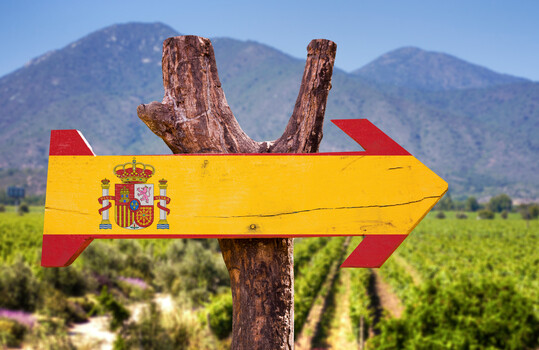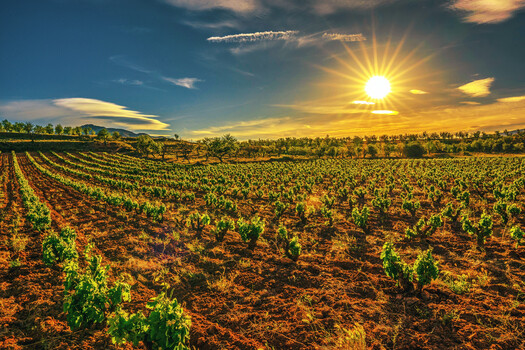Fine Wine News: What’s Trending in the World of Premium Wines - Tempranillo
Facing the Heat
Interesting developments have been afoot in Tempranillo’s heartland. Where Spain’s signature varietal is getting a refocus, albeit for less-than-encouraging reasons. Reasons that have everything to do with the star of Rioja, Navarro and Ribera del Duero accelerating in its ripening rates, towards potential picking dates arriving increasingly early.
You can guess the reason for the reasons. And because decreasing levels of acidity (alongside a range of other deficiencies) naturally concur with these developments, Tempranillo red wine could be facing a less-than-rosado future on the Iberian Peninsula.

Sustainability in warmer vintages
We’ll have a brief look at this Tempranillo wine trend and by way of a certain strategy being pursued to redeem what effects successively warmer vintages and water scarcity are having on its main regions. A strategy among strategies more specifically involving the development of alternative grape varietals to support and/or replace this and others faring less well in regions especially afflicted.
The following is but one example of Spain’s broader effort to counter the negative effects on viticulture from increasingly warm growing seasons, particularly in regions facing heat stress and drought.
New grapes on the block - Benedicto & Moribel
Ironically, the focus on Tempranillo’s plight becomes, in fact, about focusing on two relatively unfamiliar varietals sharing similar characteristics – Benedicto and Moribel.
Scientists in Castilla-La Mancha have identified these related grape varieties that show promise in enduring hotter conditions while maintaining the acidity and balance crucial to fine red wine production:
Benedicto (interestingly, a parent grape of Tempranillo), has outperformed Tempranillo in certain qualitative analyses, making it a strong candidate for future winemaking, and…
Moribel, a descendant thereof, is valued for its higher acidity, which could be crucial in maintaining balance in wines as temperatures continue to increase.
How do Benedicto and Moribel taste?
Benedicto
Noted for its structure and balance, typically showing a combination of red and black fruit flavours with a tendency toward earthy undertones.
Moribel
Known for its particularly vibrant levels of acidity. Here, a fresher, more invigorating fruit profile, with tart red fruit notes such as cherries and raspberries.
So, considering Tempranillo’s wonderful versatility in making everything from juicy, young, strawberry-flavoured reds to more serious, oak-aged expressions (typically with vanilla, liquorice, tobacco leaf and spicy flourishes to boot), here are two secondary local varietals well poised to preserve this vigour, freshness and energy should over-ripeness find its senior a bit flabby in the midriff.

Alternative strategies
Elsewhere, amidst the responses to climate pressures are some producers adjusting their viticultural practices to planting at higher altitudes, modifying pruning methods, and earlier harvesting for preserved acidity.
Moreover, more sustainability-conscious consumers are increasingly drawn to organic and biodynamic Tempranillos, with producers in Spain showing a seasoned commitment towards greener practices.
Trends in Winemaking and Consumer Preferences
In the meantime, a more positive trend for the varietal flourishes via a general consumer shift towards wines that reflect a sense of place and this sustainability.
Here, Tempranillo is well positioned. This is because its natural affinity with both traditional, age worthy wines - as so exquisitely exemplified in Bodegas Ubina’s 2004 Gran Reserva - and modern, approachable styles - a sumptuous 2020 Monte Araya Rioja Crianza - means it appeals to a broad audience.
Indeed, younger generations continue to discover the grape, but not only through new wave Rioja and Ribera del Duero expressions. They discover new denominaciónes, where Tempranillo is also ré. Where in the delightful Cariñena ‘DO’ in Aragon (due south of Rioja, north-eastern Spain) producers will typically add Cabernet Sauvignon to a Tempranillo/Garnacha mix.
Where, for example, the formidable Marqués de Tosos have crafted their exquisite Gran Reserva 2015 and an exuberant Crianza 2020 as fine examples of what remarkable value-for-money, Tempranillo-based wines can be had off-piste. Proof that the good Tempranillan life is also enjoyed beyond Spain’s major appellations.
Experiment – adapt
In the meantime, agricultural scientists will continue to experiment with alternative grape varietals to ensure a future for Tempranillo’s mainstay DOs. By their aims of maintaining quality and sustainability in these regions, the success of Benedicto and Moribel could thereby lead to them being officially recognised alongside Spain’s more traditional, international varieties.
Adaptation’s the thing. For despite a winemaking culture’s rational impulse to systemise and categorise what it cultivates, it seems Mother Nature often has other plans. Indeed, throughout mankind’s agricultural history, viti- and vini-culture never really did stand still – nor at this point do they seem interested in doing otherwise.
-- David Adamick, Mr.Wheeler Wine
